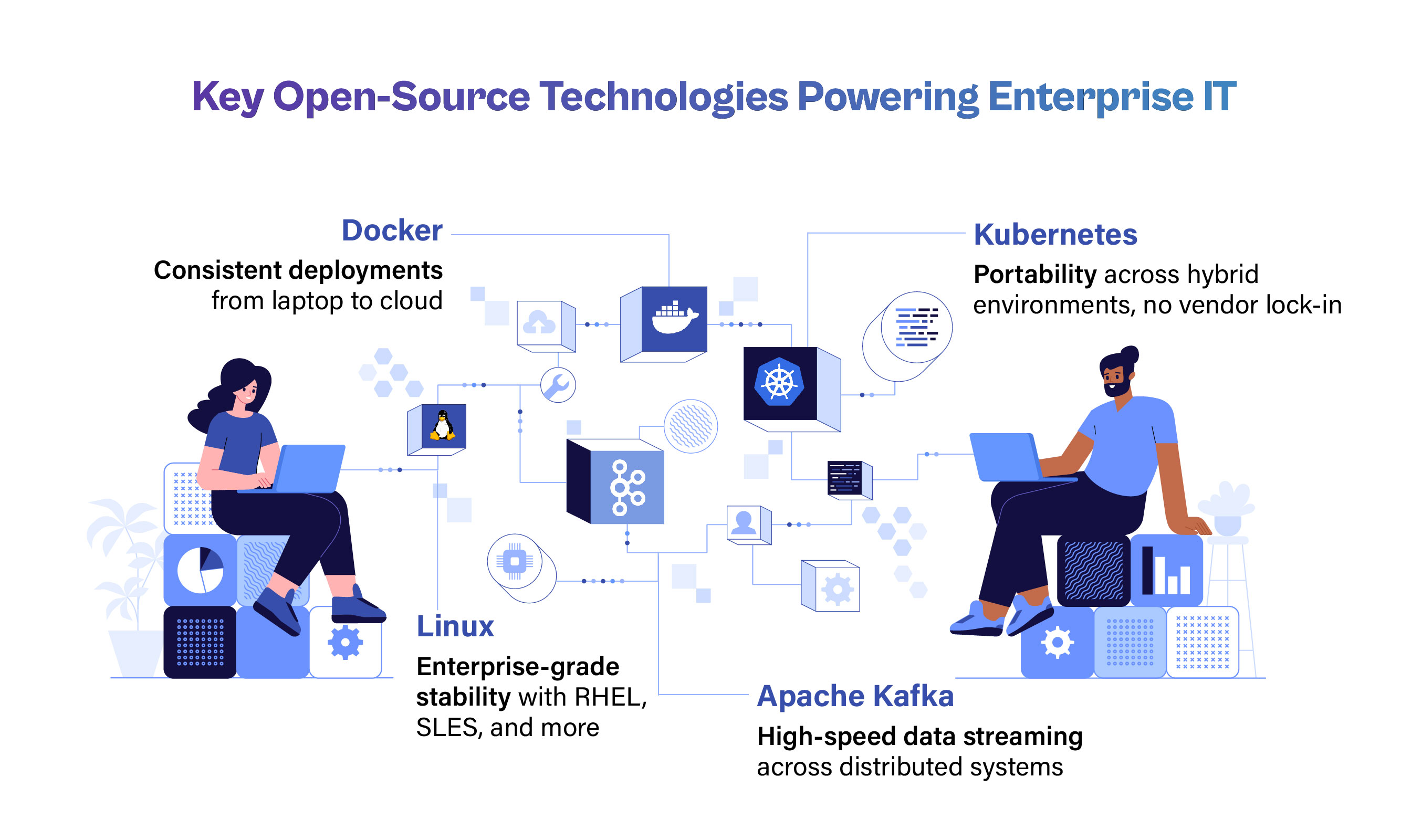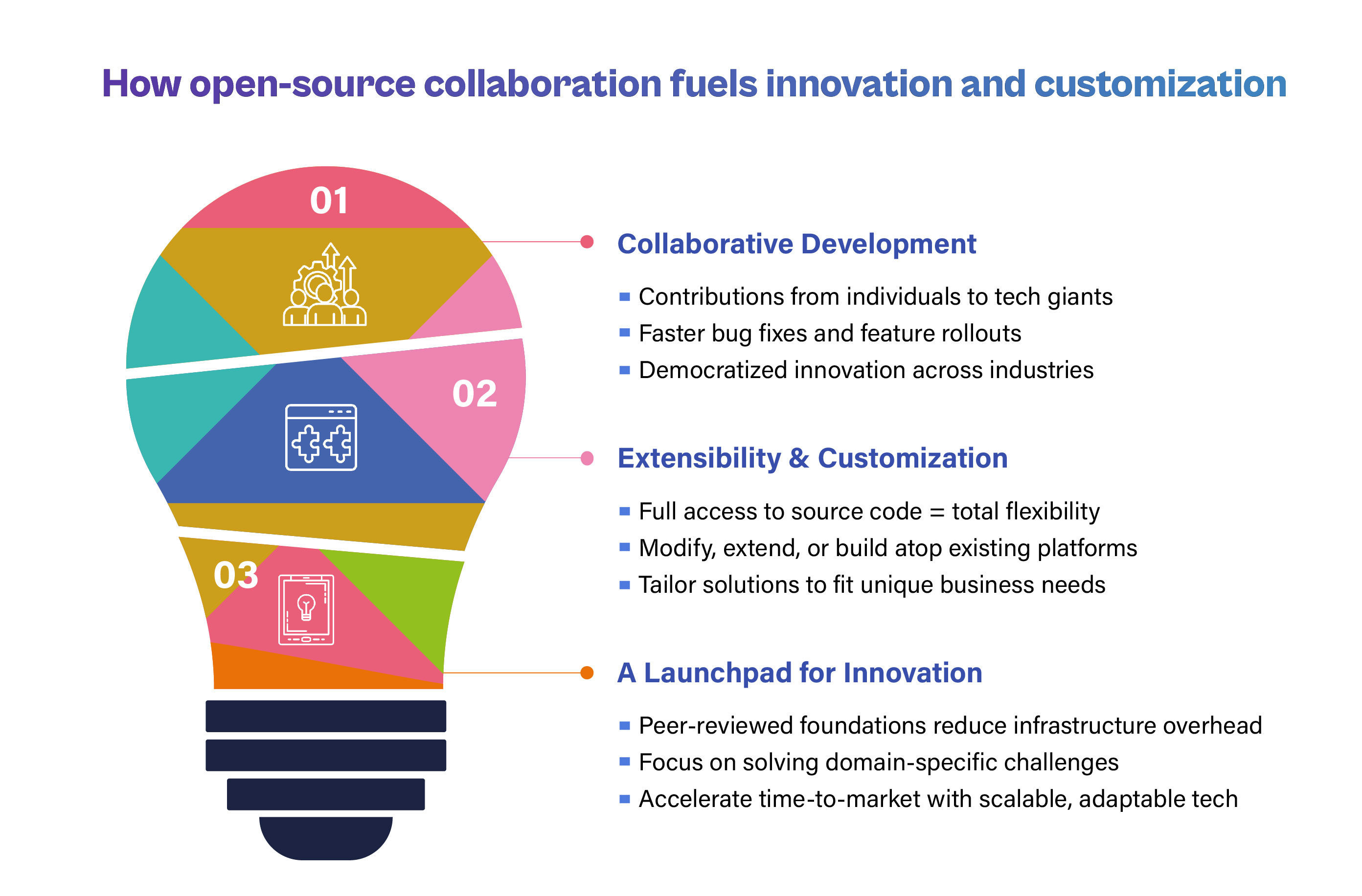How Open Source Is Driving Innovation in Enterprise IT



For today's CIOs, software architects, and engineering managers, the relentless pace of digital transformation is both a challenge and an opportunity. The demand for speed, agility, and cost-efficiency has never been greater. In this landscape, open-source software (OSS) has evolved from a fringe, "developer-only" option to a strategic imperative. It's no longer just about using a free operating system; it's about harnessing a global collaborative ecosystem to build competitive advantage.
This article explores how open-source technologies are a cornerstone of modern enterprise IT, driving innovation, and enabling organizations to build robust, scalable, and secure systems. We will delve into the major trends, the tangible benefits of adoption, the critical role of community, and the necessary governance strategies to succeed.
The Open-Source Revolution: Key Technologies Driving Change
The open-source movement has delivered a staggering array of foundational technologies that underpin the modern digital world. From the internet itself to the cloud infrastructure powering it, open source is everywhere.
Here are some of the most impactful trends and projects shaping enterprise IT today.

Kubernetes: The Orchestrator of the Cloud-Native World
Kubernetes isn’t just a tool, it’s the backbone of modern cloud-native architecture. Born at Google and now the industry standard, this open-source container orchestration platform transforms how enterprises deploy, scale, and manage applications. By abstracting infrastructure complexity, Kubernetes empowers teams to move faster, build smarter, and operate with confidence.
For forward-looking organizations, Kubernetes delivers three game-changing advantages:
- Portability without compromise: Containerized applications run seamlessly across on-prem, private, and public clouds, eliminating vendor lock-in and unlocking true infrastructure freedom.
- Built-in resilience: With automated failover, dynamic scaling, and intelligent workload distribution, Kubernetes ensures high availability, even under pressure from traffic spikes or hardware failures.
- Operational efficiency: It simplifies the orchestration of microservices, freeing developers from infrastructure headaches and allowing them to focus on innovation and velocity.
In a world where speed, reliability, and flexibility define competitive edge, Kubernetes is the foundation that makes it all possible.
Docker: The Enabler of Containerization
If Kubernetes is the orchestrator, Docker is the enabler. As the open-source platform that revolutionized containerization, Docker empowers developers to package applications, along with all their dependencies, into lightweight, portable containers that run identically across environments. It eliminates the friction of “it works on my machine,” replacing it with predictable, repeatable deployments from laptop to cloud.
The Docker-Kubernetes duo is a cornerstone of modern DevOps. Developers build with Docker; Kubernetes scales and manages those containers in production. Together, they power agile CI/CD pipelines, accelerate release cycles, and bring industrial-grade consistency to software delivery.
By standardizing how applications are packaged and deployed, Docker has become indispensable for enterprises driving digital transformation. It’s not just a developer too, it’s a strategic asset for building resilient, scalable, and cloud-native systems.
Linux: The Unsung Hero of Modern Infrastructure
Before cloud-native was a movement, Linux was already shaping the future. As the backbone of enterprise servers, cloud infrastructure, and everything from embedded systems to supercomputers, Linux has quietly powered the digital world with unmatched stability, security, and flexibility.
Enterprise-grade distributions like Red Hat Enterprise Linux (RHEL) and SUSE Linux Enterprise Server (SLES) bring the rigor and reliability that global organizations demand, offering long-term support, hardened security, and commercial-grade performance. But it’s the open-source ethos that truly sets Linux apart: a global community continuously audits, improves, and evolves the codebase, ensuring a resilient foundation for mission-critical workloads.
Linux isn’t just an operating system, it’s the bedrock of modern IT. Without it, the cloud-native revolution wouldn’t exist. It’s the trusted layer beneath Kubernetes, Docker, and every scalable, secure, and future-ready architecture.
Apache Kafka: The Central Nervous System for Data
In a world where data drives every decision, speed is everything. Apache Kafka delivers that speed, acting as the central nervous system for real-time data movement across modern enterprises. Originally engineered at LinkedIn to handle massive, high-velocity data streams, Kafka has evolved into the open-source standard for distributed event streaming at scale.
Kafka enables applications to publish, subscribe, and process streams of records with unmatched scalability, durability, and fault tolerance. It’s more than a messaging queue, it’s the foundation for building real-time data pipelines, streaming analytics platforms, and event-driven microservices architectures.
For enterprises, Kafka unlocks the ability to act on data as it happens, powering responsive systems, predictive insights, and agile decision-making. In the race to become truly data-driven, Kafka isn’t just an advantage, it’s a necessity.
The Business Case for Open Source: Driving Value and Agility
Open-source adoption isn’t just a technical choice, it’s a business strategy. Forward-thinking organizations are embracing open technologies to unlock cost savings, accelerate innovation, and future-proof their operations.
Here’s why open source is reshaping enterprise IT:
Cost-Effectiveness with Strategic Flexibility
Open source eliminates the burden of proprietary licensing fees, freeing up capital for high-impact investments in talent, infrastructure, and innovation. Enterprises can start lean, experiment freely, and scale without committing to massive upfront costs, making open source a financially agile choice.
Beyond cost savings, it enables iterative development, rapid prototyping, and the ability to pivot without financial penalties. This flexibility empowers teams to test new ideas, sunset outdated tools, and reallocate resources based on evolving prioritise, without being locked into rigid vendor contracts.
Speed, Agility and Innovation at Scale
Community-driven development means open-source projects evolve rapidly, often outpacing closed-source alternatives. Enterprises gain immediate access to cutting-edge features and can customize solutions to fit their exact needs, unlocking a level of agility and responsiveness that proprietary software simply can’t match.
This velocity translates into faster time-to-market, quicker bug resolution, and the ability to co-create with a global developer base. Organizations can respond to customer demands in real time, integrate emerging technologies, and stay ahead of competitors by continuously iterating on their digital capabilities.
Freedom from Vendor Lock-in
Open standards empower organizations to choose their own path, whether that’s shifting between cloud providers, integrating diverse tools, or negotiating better terms. This flexibility isn’t just technical, it’s strategic leverage that protects against dependency and fosters resilience.
By avoiding proprietary silos, enterprises gain control over their architecture, reduce switching costs, and maintain autonomy in decision-making. This freedom supports hybrid and multi-cloud strategies, future-proofing infrastructure while enabling seamless interoperability across platforms, vendors, and ecosystems.
Enhanced Security and Reliability
Open-source software benefits from constant scrutiny by a global community of developers. Vulnerabilities are identified and patched faster, and the transparency of the codebase ensures accountability. The result: systems that are not only secure, but continuously hardened by collective expertise.
Security through visibility means issues are surfaced early and resolved collaboratively. Enterprises can audit code, apply custom security policies, and benefit from peer-reviewed best practices, creating a robust defense posture that evolves with emerging threats and compliance requirements.
Access to Top Talent
Today’s developers are fluent in open-source ecosystems, and they want to work where their skills matter. By adopting open technologies, enterprises create modern, engaging environments that attract top-tier talent and foster a culture of innovation and collaboration.
Open-source fluency signals technical maturity and forward-thinking leadership. It enables internal teams to contribute to public projects, build reputational capital, and stay aligned with industry trends. This not only boosts hiring appeal but also drives retention by empowering developers to do meaningful, visible work.
Success Stories
Netflix: Scaling Global Streaming with Open Source
- Netflix built its streaming empire on open-source technologies including Linux, Docker, and Kubernetes.
- These tools enable Netflix to manage massive workloads, automate deployments, and maintain high availability across global infrastructure.
- Netflix OSS also contributed tools like Eureka and Hystrix, which influenced microservices architecture across the industry.
- Their use of Kubernetes allows for dynamic scaling and fault-tolerant service orchestration.
Source: Netflix OSS, Spring Cloud, or Kubernetes? How About All of Them!
Spotify: Real-Time Personalization with Apache Kafka
- Spotify uses Apache Kafka to power its real-time data pipelines and recommendation engine.
- Kafka enables Spotify to ingest, process, and act on massive volumes of user data instantly.
- This architecture supports personalized playlists, dynamic recommendations, and responsive user experiences.
- Kafka’s event-driven model ensures scalability and fault tolerance across Spotify’s global user base.
Source: System Design of Spotify
IBM & Red Hat: Commercializing Open Source for the Enterprise
- IBM’s acquisition of Red Hat solidified its commitment to open-source innovation.
- Red Hat Enterprise Linux (RHEL) and OpenShift offer enterprise-grade support, security, and scalability.
- IBM provides 24x7 support, proactive services, and tooling for mission-critical workloads built on open-source platforms.
- This model proves that open-source can thrive commercially while delivering robust solutions for hybrid cloud, AI, and DevOps.
Source: Red Hat and IBM: Accelerating the Adoption of Open Source
The Power of Community and the Promise of Extensibility
At the heart of open-source success lies its community, a dynamic, global network of contributors that fuels innovation, resilience, and long-term sustainability. This collective intelligence isn’t just a support system; it’s the engine that drives continuous evolution and relevance.

Collaborative Development
Open-source projects flourish through contributions from individuals, startups, and enterprise giants alike. A bug fix submitted by a small developer can ripple across industries, while a feature enhancement from a major tech company becomes accessible to all. This inclusive, collaborative model accelerates development cycles, democratizes innovation, and ensures that projects remain adaptable to changing needs and technologies.
Extensibility and Customization
With open access to source code, enterprises are no longer bound by rigid vendor roadmaps. They gain the freedom to tailor solutions to their exact requirements—whether by modifying core functionality, building proprietary extensions, or developing entirely new products atop the open-source foundation. This extensibility empowers organizations to differentiate themselves in competitive markets. For instance, a company might leverage an open-source database while engineering custom plugins to integrate with its internal analytics stack, creating a solution uniquely suited to its business goals.
A Foundation for Innovation
Open-source isn’t a finished product, it’s a launchpad. It offers a robust, peer-reviewed, and widely adopted foundation that allows engineering teams to bypass the heavy lifting of building core infrastructure. Instead, they can channel their efforts into solving domain-specific challenges, accelerating time-to-market, and delivering unique value. In this way, open-source becomes not just a tool, but a strategic asset, enabling enterprises to innovate faster, scale smarter, and build with confidence.
Seamless Integration with Modern Tooling
Open-source technologies are designed to be part of a larger, interconnected ecosystem. They integrate seamlessly with modern practices like CI/CD, observability, and security tooling, enabling a holistic approach to software development and operations.
CI/CD (Continuous Integration/Continuous Delivery)
CI/CD pipelines automate the process of building, testing, and deploying software. Open-source tools are the backbone of most modern CI/CD systems. Jenkins, GitLab CI/CD, and Tekton are just a few examples of open-source tools that enable teams to create automated, repeatable pipelines. When combined with Docker and Kubernetes, a developer can push a code change to a Git repository, and an automated pipeline will build a new container image, test it, and deploy it to a production Kubernetes cluster, all without manual intervention. This level of automation is essential for rapid, high-quality software delivery.
Observability: The Eyes and Ears of Your Systems
In a distributed, microservices-based environment, understanding the behavior of your systems is a significant challenge. Observability, the ability to understand the internal state of a system by examining its external outputs, is a critical practice. Open-source has provided the industry with a suite of powerful observability tools.
- Prometheus: A monitoring system and time-series database that allows teams to collect and query metrics from their applications and infrastructure.
- Grafana: A data visualization and dashboarding tool that integrates with Prometheus and many other data sources, allowing for powerful, real-time insights into system performance.
- Fluentd/Fluent Bit: Log collectors that standardize and centralize logging from various sources, making it easier to analyze and troubleshoot issues.
These tools, often used together as part of a "CNCF landscape," give engineering teams the visibility they need to maintain the health and performance of their systems at scale.
Security Tooling: Shifting Left
Security in a cloud-native world requires a "shift-left" approach, where security is integrated into every stage of the development lifecycle. Open-source tools play a vital role in this.
- Static Application Security Testing (SAST): Tools like SonarQube analyze source code to identify potential vulnerabilities early in the development process.
- Software Composition Analysis (SCA): Tools that scan open-source dependencies to identify known vulnerabilities.
- Container Security: Tools such as Trivy and Clair scan container images for security vulnerabilities before they are deployed.
By integrating these open-source tools into CI/CD pipelines, enterprises can automate security checks, ensuring that security is not an afterthought but an integral part of the development process.
Governance: Scaling Open-Source Use Strategically
While the benefits of open-source are clear, simply adopting a few projects is not enough. To scale its use successfully and mitigate potential risks, enterprises must establish a robust governance model.
1. The Open-Source Program Office (OSPO): A dedicated OSPO is a team or a virtual function responsible for managing and guiding the organization's open-source strategy. Its responsibilities include:
- Policy Definition: Creating clear policies for how teams can use, contribute to, and manage open-source software.
- License Compliance: Ensuring that all open-source components are used in compliance with their respective licenses to avoid legal risks.
- Security Vetting: Establishing a process for vetting open-source projects for security vulnerabilities and long-term viability.
- Community Engagement: Encouraging and managing the organization's contributions back to the open-source community.
2. Standardized Tooling and Platforms: As open-source adoption grows, it is crucial to standardize the tooling and platforms used across the organization. This prevents fragmentation and ensures that engineering teams can move between projects with minimal friction. For example, standardizing on a single Kubernetes distribution and a consistent set of observability tools can dramatically improve operational efficiency.
3. Internal Training and Expertise: Investing in training and building internal expertise is key. This includes training developers on how to use open-source tools effectively, teaching architects how to design systems around open-source components, and educating legal and procurement teams on the nuances of open-source licenses.
4. Commercial Open Source and Support: Many enterprises choose to leverage commercial open-source offerings from vendors like Red Hat, SUSE, or Cloudera. These companies provide enterprise-grade support, security patches, and services, offering the best of both worlds: the flexibility of open-source with the reliability and accountability of a commercial partner. This hybrid approach is often the most pragmatic path for large organizations.
Conclusion
The open-source movement has matured into a powerful, transformative force in enterprise IT. It has democratized technology, accelerated innovation, and provided enterprises with the tools they need to build modern, agile, and resilient systems. From the foundational operating system of Linux to the cloud-native orchestrators of Kubernetes and Docker, and the real-time data platforms like Apache Kafka, open-source is at the heart of the digital economy.
For IT leaders, the path forward is clear: embrace open-source not as a cost-cutting measure, but as a strategic enabler of business value. This requires a cultural shift towards collaboration and transparency, a clear governance framework to manage risk, and a commitment to investing in the talent and processes needed to succeed. The enterprises that will lead in the next decade are those that have harnessed the collective intelligence of the open-source community, transforming it into a powerful engine for their own innovation.
To read more insightful resources on open-source adoption and enterprise IT transformation, explore Cogent Infotech’s resource hub. Stay ahead with guides, case studies, and expert insights designed for today’s technology leaders.
[Explore Resources]







%402x.svg)






